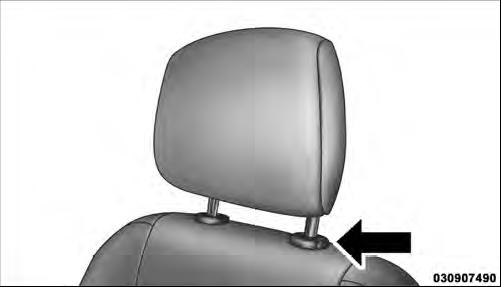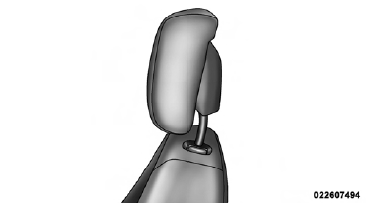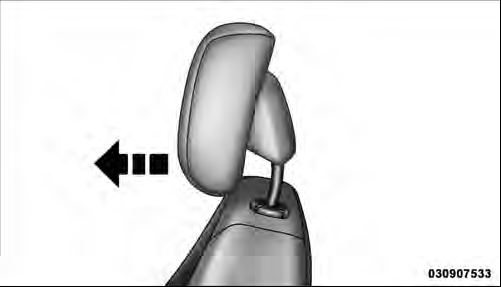 Jeep Liberty: Active Head Restraints — Front Seats
Jeep Liberty: Active Head Restraints — Front Seats
Active Head Restraints are passive, deployable components, and vehicles with this equipment cannot be readily identified by any markings, only through visual inspection of the head restraint. The head restraint will be split in two halves, with the front half being soft foam and trim, the back half being decorative plastic.
When AHRs deploy during a rear impact, the front half of the head restraint extends forward to minimize the gap between the back of the occupant’s head and the AHR.
This system is designed to help prevent or reduce the extent of injuries to the driver and front passenger in certain types of rear impacts. Refer to “Occupant Restraints” in “Things To Know Before Starting Your Vehicle” for further information.
To raise the head restraint, pull upward on the head restraint. To lower the head restraint, press the adjustment button, located at the base of the head restraint, and push downward on the head restraint.

Adjustment Button
For comfort the Active Head Restraints can be tilted forward and backward. To tilt the head restraint closer to the back of your head, pull forward on the bottom of the head restraint. Push rearward on the bottom of the head restraint to move the head restraint away from your head.

Active Head Restraint (Normal Position)

Active Head Restraint (Tilted)
NOTE:
• The head restraints should only be removed by qualified
technicians, for service purposes only. If either of
the head restraints require removal, see your authorized
dealer.
• In the event of deployment of an Active Head Restraint, refer to “Occupant Restraints/Resetting Active Head Restraints (AHR)” in “Things To Know Before Starting Your Vehicle” for further information.
WARNING!
• Do not place items over the top of the Active Head
Restraint, such as coats, seat covers or portable
DVD players. These items may interfere with the
operation of the Active Head Restraint in the event
of a collision and could result in serious injury or
death.
• Active Head Restraints may be deployed if they are struck by an object such as a hand, foot or loose cargo. To avoid accidental deployment of the Active Head Restraint ensure that all cargo is secured, as loose cargo could contact the Active Head Restraint during sudden stops. Failure to follow this warning could cause personal injury if the Active Head Restraint is deployed.
 Head Restraints
Head Restraints
Head restraints are designed to reduce the risk of injury
by restricting head movement in the event of a rear
impact. Head restraints should be adjusted so that the top
of the head restraint is ...
 Rear Head Restraints
Rear Head Restraints
The two outboard seat are equipped with adjustable head
restraints. To raise the head restraint, pull upward on the
head restraint. To lower the head restraint, press the
adjustment button, loca ...
See also:
Beltminder
A front and rear seat Beltminder system warns
the driver when the seat belt of an occupied
seat is not fastened or is unfastened during a
journey.
Beltminder
A graphic accompanied by a text mes ...
Selecting category (only when connecting iPod®)
When the
button is pressed for less
than 1.5 seconds, the iPod® menu is
displayed.
Each time you turn the “TUNE/TRACK/
CH” dial clockwise, the displayed category
changes in the followi ...
Mute/Un-Mute (Mute OFF)
When you mute the Uconnect™ Phone, you will still be
able to hear the conversation coming from the other
party, but the other party will not be able to hear you. In
order to mute the Uconnectâ ...
